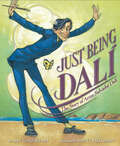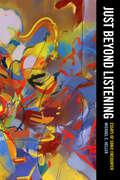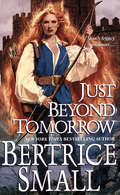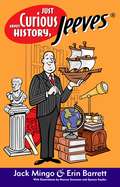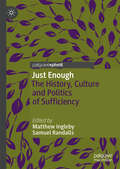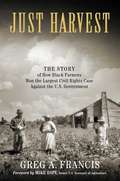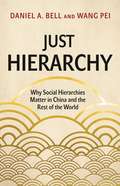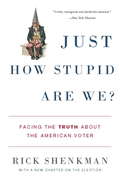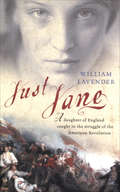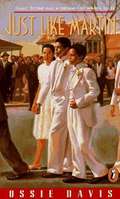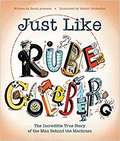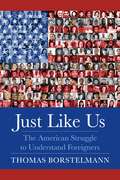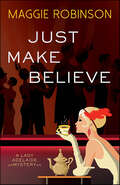- Table View
- List View
Just Being Dalí: The Story of Artist Salvador Dalí
by Amy GuglielmoThis kid-friendly picture book biography celebrates the irrepressible individuality of Surrealist artist Salvador Dalí.Salvador Dalí just couldn't help being himself. When he was little, he wasn't like the other children; he was a daydreamer who liked to play pretend. When he grew up, he became an artist, but he didn't want to make art that looked like everyone else's. He became the most famous painter of his time after he made a picture of melting clocks. He liked to do wild, attention-grabbing things: He drove a fancy car stuffed with 1,000 pounds of cauliflower. He gave a speech inside a deep-sea diving suit. And he took his pet ocelot Babou to lunch at snooty restaurants. He designed lollipop wrappers in exchange for free candy, a lobster phone that really worked, and a hat made out of a shoe! Here's the true story of the one and only Salvador Dalí, an artist who never stopped being himself.
Just Beyond Listening: Essays of Sonic Encounter (California Studies in Music, Sound, and Media #5)
by Michael C. HellerJust Beyond Listening asks how we might think about encounters with sound that complicate standard accounts of aurality. In a series of essays, Michael C. Heller considers how sound functions in dialogue with a range of sensory and affective modalities, including physical co-presence, textual interference, and spectral haunting. The text investigates sound that is experienced in other parts of the body, altered by cross-wirings of the senses, weaponized by the military, or mediated and changed by cultural practices and memory. Building on recent scholarship in sound studies and affect theory, Heller questions not only how sound propagates acoustically but how sonic presences temper our total experience of the world around us.
Just Beyond Tomorrow (Skye's Legacy #5)
by Bertrice SmallCapturing the hearts and imaginations of millions worldwide, Bertrice Small's novels always deliver the lush sensuality her readers expect. In Just Beyond Tomorrow, Jasmine's strong-willed son, Patrick Leslie, continues Skye's Legacy when he takes a wife who wants no husband. . .Just Beyond TomorrowWith his father dead and his mother in France, Patrick Leslie, Duke of Glenkirk, discovers the obligations of the estate and its people are now his alone. But during a day of hunting, a chance meeting ensures that he will not be alone much longer, for to obtain the deserted castle and lands adjoining his, Patrick must agree to take something else, as well--a bride.Flanna Brodie, heiress to Brae, is as vibrant and beautiful as the Scottish countryside, and just as wild. She wants no man--only her freedom. But the passions Patrick awakens in her run deeper than those of the flesh. The independent Flanna is determined to champion the royal Stuarts' cause, and restore Charles II to his throne despite her husband's objections. Patrick knows the dangers of such political intrigues; that the Stuarts have always brought misfortune to the Leslies of Glenkirk, and that a roguish king will ask far more of the naïve duchess than a simple vow of fealty--forcing Patrick and Flanna to choose between the threat of wounded pride, and the promise of a lasting love both secretly yearn for...
Just Curious About History, Jeeves®
by Jack Mingo Erin BarretYou'll get the answers to these fascinating questions and many, many more in the wildly entertaining, un-put-down-able Just Curious About History, Jeeves. Based on the legion of unexpected questions posed at the popular Ask Jeeves Web site, Just Curious tackles all the puzzlers, bafflers, and stumpers that find their way into our everyday lives. What were the Pig Wars and were they actually caused by pigs? Who were the first gangsters? Did Cleopatra really wear makeup? Was Ivan the Terrible that terrible? Sure curiosity killed the cat, but satisfaction brought him back. So if you want to know how tall Napoleon was, whether Captain Kidd had any little Kidds, or who the heck Charles the Fat was, look no further than Just Curious About History, Jeeves- the unequivocal say-all, end-all, be-all authority on history's who, what, where, when, why, and how.
Just Desserts (Fountas & Pinnell Classroom, Guided Reading)
by Jackie Parker Chris CoadyNIMAC-sourced textbook. Standing Up to Alice. Elizabeth puts up with giving her own food to Alice, the Head Girl at the orphan school, but she can't stand watching the other girls starve. Alice is big, strong, and mean—and she carries a switch for beating. How can Elizabeth stand up to her?
Just Doing My Job: Stories of Service from World War II
by Jonna Doolittle HoppesPreserving the personal histories of civilians and soldiers who united to defend America during the Second World War, this oral history tells the stories of ordinary citizens who left jobs and families behind to contribute to the war effort. Chronicling the sacrifices made by otherwise average people, this keepsake features profiles and interviews with the men and women who responded to the call to action by putting their lives on hold to fight for their country at home and abroad. From soldiers and spies to factory workers and nurses, the heroes profiled in this history include Dick Hamada, a Japanese-American who became a spy with the Office of Strategic Services; Edith McClure, an army nurse stationed in England; Bobby Hite, one of the famed Doolittle Raiders, who was captured by the Japanese and endured years of torture and solitary confinement; and pilot Bob Hoover, who was shot down over enemy territory and imprisoned but managed to escape by stealing a German plane.
Just Enough Design: Reflections on the Japanese Philosophy of Hodo-hodo
by Taku SatohA Japanese designer offers a compelling alternative way to engage with our possessions, our history, our environment, and each other. The Japanese phrase "hodo-hodo" originates in ancient times. When contemporary designer Taku Satoh applies it to his work, it means "just enough." Hodo-hodo design deliberately holds back, leaving room for individuals to engage with objects according to their unique sensibilities. In the midst of a consumerist age, Satoh has built an illustrious design career around this philosophy, creating iconic work in fashion, food, and architecture. His ideas speak not just to professional designers, but to anyone who wishes to move more thoughtfully through the world. Within this slim but powerful volume, Satoh explains his philosophy through tangible examples—from the aesthetic of a timeworn ramen shop to a rooftop playground inspired by onomatopoeia. Urging readers to appreciate everyday objects and spaces and to question the lure of convenience, he delivers a message rooted in the past yet perfectly suited to our times. TIMELY TOPIC: As more people begin to question the structures of consumerism, this thoughtful book offers a different way of seeing the world. Satoh's philosophy aligns perfectly with sustainable lifestyles. UNIQUE INSIGHTS INTO JAPANESE CULTURE: Japan is a huge cultural exporter and a booming travel destination. Many Japanese ideas and traditions—such as ikigai, forest bathing, and wabi-sabi—are being widely celebrated as pathways to a more fulfilling life. This book presents hodo-hodo, a concept not yet widely exported. Learning about hodo-hodo will enrich readers' understanding of Japan, as well as inspire designers and other creatives in their work. AUTHORITATIVE VOICE: Taku Satoh has over four decades of design experience. His work is renowned in Japan, and he's worked with major brands and museums and won many awards. Here, he shares wisdom drawn from his design expertise and his deep love for his culture. ACCESSIBLE CONTENT: The handy paperback format is perfect for a book that you will want to read and re-read. Satoh proposes fascinating and pertinent ideas in an unintimidating way. Perfect for:Designers and design studentsCreatives of all kindsReaders passionate about sustainabilityAnyone interested in Japanese culture and history
Just Enough to Put Him Away Decent: Death Care, Life Extension, and the Making of a Healthier South, 1900-1955
by Kristine M. McCuskerAs the twentieth century began, Black and white southerners alike dealt with low life expectancy and poor healthcare in a region synonymous with early death. But the modernization of death care by a diverse group of actors changed not only death rituals but fundamental ideas about health and wellness. Kristine McCusker charts the dramatic transformation that took place when southerners in particular and Americans in general changed their thinking about when one should die, how that death could occur, and what decent burial really means. As she shows, death care evolved from being a community act to a commercial one where purchasing a purple coffin and hearse ride to the cemetery became a political statement and the norm. That evolution also required interactions between perfect strangers, especially during the world wars as families searched for their missing soldiers. In either case, being put away decent, as southerners called burial, came to mean something fundamentally different in 1955 than it had just fifty years earlier.
Just Enough: The History, Culture and Politics of Sufficiency
by Samuel Randalls Matthew InglebyThis book fosters a wide-ranging and nuanced discussion of the concept of ‘enough’. Acknowledging the prominence of notions of sufficiency in debates about sustainability, it argues for a more complex, culturally and historically informed understanding of how these might be manifested across a wide array of contexts. Rather than simply adding further case studies of sufficiency in order to prove the efficacy of what might be called ‘finite planet economics’, the book holds up to the light a crucial ‘keyword’ within the sustainability discourse, tracing its origins and anatomising its current repertoire of usages. Chapters focus on the sufficiency of food, drink and clothing to track the concept of 'enough' from the Middle Ages to the 21st century.By expanding the historical and cultural scope of sufficiency, this book fills a significant gap in the current market for authors, students and the wider informed audience who want to more deeply understand the changing and developing use of this term.
Just For Her
by Katherine O' NealThe secrets they keep are priceless.Under cover of darkness, they will steal something more precious. . . Beneath the sparkling façade of wealth and elegance, Jules Habsburg is living a nightmare--blackmailed into marriage by the unscrupulous robber baron Dominic DeRohan, the same man who gunned down her lover. Until the night she awakens to find a stranger in her bedroom--the notorious cat burglar known to Cote d'Azur as the Panther. Her blood pounding, she recognizes in him the one man strong enough to free her from the sadistic shackles of her husband. . . But the Panther is not one to be manipulated, even by a woman whose provocative beauty is matched only by her determination. Now, in the hedonistic playground of artists, actors, and aristocrats, Jules is losing her closely guarded heart to a man without identity. As forbidden passion deepens to love, is there even more danger for her in an alliance with a seductive man whose secrets could destroy them both?
Just Freedom: Inside Florida’s Decades-Long Voting Rights Battle
by Daniel RiveroThe story of an extraordinary expansion of voting rights and the obstacles holding back its implementation When Florida citizens voted in 2018 to pass Amendment 4 to the state constitution, which promised to restore voting rights to people with past felony convictions, the decision was celebrated as a civil rights victory and the nation’s largest expansion of voting rights in almost 50 years. In Just Freedom, Daniel Rivero details the advocacy and action that led to this moment—and shows what went wrong in the years after the amendment’s passing.The story begins in the Reconstruction era with Florida’s 1868 lifetime voting ban for people with past felony convictions. The infamous 2000 Bush/Gore election brought the ban to national attention, sparking a wave of activism against it. Rivero follows the 18-year path to Amendment 4 through the grassroots work of people including Howard Simon of the American Civil Liberties Union of Florida and Desmond Meade, a formerly incarcerated man and president of the Florida Rights Restoration Coalition.A journalist who has covered this story for many years, Rivero uses court documents, meeting transcripts, archival videos, interviews, and eyewitness courtroom scenes and street marches to peel back the layers and reveal the motives that supported and opposed this human rights initiative. He shows how political polarization, implementation challenges, and monetary interests have stalled the amendment from becoming fully realized to this day.At once a contemporary legal tale and a series of interwoven stories of people at the center of the fight, this is the account of how 1.4 million Floridians gained the right to vote—and the obstacles still preventing them from doing so. Just Freedom will raise questions and provoke conversations about the lasting hold of Jim Crow–era policies, the power of money, and the nature of the American criminal justice system.
Just Harvest: The Story of How Black Farmers Won the Largest Civil Rights Case against the U.S. Government
by Greg FrancisWhen a class-action lawsuit against the US government results in a billion dollar settlement for the aggrieved parties, you&’d expect the story to be headline news . . .to be posted on social media everywhere . . . to be adapted to film or even to a popular legal procedural series on TV . . .So why then have so many people never heard of Pigford vs. Glickman? Or the follow-up lawsuit, Pigford II? Or the Black Farmers Case, as the pair of these legal actions is often called? Could it be that the heart-wrenching story of Black farmers in America, and the monumental legal case that brought long-sought justice to them, is rarely told because it reflects so poorly on the US and its treatment of those whose ancestors helped make the nation an agricultural giant in the first place? Whatever the reason, the time to tell the full story has come and the person to share the gripping details is Greg Francis, one of the lead counsels in the historic case that finally helped Black farmers achieve equity. In Just Harvest, Francis narrates the dramatic twists and turns of the legal battle fought and won, and evidences the many years of ingrained discrimination and racism that preceded it. Awareness of this story makes us all witnesses to the history still unfolding— and while parts of what is recounted herein will enrage you, the hope is that this book will also inspire, inform, and motivate you to join the continuing fight for the rights of all Black farmers now and in the future.
Just Here, Doctor (The Dr Clifford Chronicles)
by Dr Robert CliffordJust Here, Doctor is the true story of a young country doctor and his patients - a richly entertaining and humorous chronicle of the life of a small West Country community as seen through the eyes of its G.P. Dr Clifford has some marvellous stories to tell: about the home delivery of a cricket fan's baby - in between overs of a televised Test Match; of the time he rode off on a gigantic horse to attend a hunting casualty - and rode back in an ambulance as the casualty; and the amazing saga of his student rugby tour of France - the craziest, most drunken ever undertaken. Here too, on the more serious side, are moving accounts of the courage of ordinary people in the face of serious, even fatal illness. Teeming with colourful and curious places and characters, Just Here, Doctor is packed with comedy, drama and tragedy, every bit as warm and enthralling as James Herriot's famous stories of a vet's life.
Just Hierarchy: Why Social Hierarchies Matter in China and the Rest of the World
by Daniel A. BellA trenchant defense of hierarchy in different spheres of our lives, from the personal to the politicalAll complex and large-scale societies are organized along certain hierarchies, but the concept of hierarchy has become almost taboo in the modern world. Just Hierarchy contends that this stigma is a mistake. In fact, as Daniel Bell and Wang Pei show, it is neither possible nor advisable to do away with social hierarchies. Drawing their arguments from Chinese thought and culture as well as other philosophies and traditions, Bell and Wang ask which forms of hierarchy are justified and how these can serve morally desirable goals. They look at ways of promoting just forms of hierarchy while minimizing the influence of unjust ones, such as those based on race, sex, or caste.Which hierarchical relations are morally justified and why? Bell and Wang argue that it depends on the nature of the social relation and context. Different hierarchical principles ought to govern different kinds of social relations: what justifies hierarchy among intimates is different from what justifies hierarchy among citizens, countries, humans and animals, and humans and intelligent machines. Morally justified hierarchies can and should govern different spheres of our social lives, though these will be very different from the unjust hierarchies that have governed us in the past.A vigorous, systematic defense of hierarchy in the modern world, Just Hierarchy examines how hierarchical social relations can have a useful purpose, not only in personal domains but also in larger political realms.
Just Hierarchy: Why Social Hierarchies Matter in China and the Rest of the World
by Daniel Bell Wang PeiA trenchant defense of hierarchy in different spheres of our lives, from the personal to the politicalAll complex and large-scale societies are organized along certain hierarchies, but the concept of hierarchy has become almost taboo in the modern world. Just Hierarchy contends that this stigma is a mistake. In fact, as Daniel Bell and Wang Pei show, it is neither possible nor advisable to do away with social hierarchies. Drawing their arguments from Chinese thought and culture as well as other philosophies and traditions, Bell and Wang ask which forms of hierarchy are justified and how these can serve morally desirable goals. They look at ways of promoting just forms of hierarchy while minimizing the influence of unjust ones, such as those based on race, sex, or caste.Which hierarchical relations are morally justified and why? Bell and Wang argue that it depends on the nature of the social relation and context. Different hierarchical principles ought to govern different kinds of social relations: what justifies hierarchy among intimates is different from what justifies hierarchy among citizens, countries, humans and animals, and humans and intelligent machines. Morally justified hierarchies can and should govern different spheres of our social lives, though these will be very different from the unjust hierarchies that have governed us in the past.A vigorous, systematic defense of hierarchy in the modern world, Just Hierarchy examines how hierarchical social relations can have a useful purpose, not only in personal domains but also in larger political realms.
Just How Stupid Are We?: Facing the Truth About the American Voter
by Rick ShenkmanFifty percent of Americans can name four characters from "The Simpsons,” but only two out of five can name all three branches of the federal government. No more than one in seven can find Iraq on a map. Just how stupid are we? Pretty stupid. In Just How Stupid Are We?, best-selling author Rick Shenkman takes aim at our great national piety: the wisdom of the American people. American democracy is as direct as it’s ever been--but voters are misusing, abusing, and abdicating their political power. At once a powerful indictment of voter apathy and political indifference, Just How Stupid Are We? also provides concrete proposals for reforming our institutions--the government, the media, civic organizations, political parties--to make them work better for the American people. But first, Shenkman argues, we must reform ourselves.
Just Jackie: Her Private Years (Core Ser.)
by Edward KleinShe was perhaps the most famous, most scrutinized, most talked about woman of our century. From the moment Jacqueline Kennedy stepped into the White House, she inspired a generation of Americans and changed the face of a nation. But underneath the glitter and the hype, just who was Jackie? Now, in this carefully detailed chronicle, Edward Klein, the former editor in chief of The New York Times Magazine, bestselling author of All Too Human: The Love Story of Jack and Jackie Kennedy, and friend of Jacqueline Kennedy Onassis for many years, tells the story of Jackie's best years as it has never been told before, shedding an entire new light on her enduring legacy. Edward Klein has amassed a wealth of exclusive information from private documents and correspondence, FBI files, and hundreds of interviews with Jackie's friends, the associates of her second husband, Greek shipping tycoon Aristotle Onassis, and her longtime lover, the mysterious diamond merchant Maurice Templesman. In this extraordinary, myth-shattering book, many people break their silence for the first time, answering dozens of provocative questions: * Why did Jackie marry Onassis? Was it only for the money? * How did she react when Onassis resumed his affair with Maria Callas? * What was the real reason their marriage fell apart? * When Jackie returned to New York, how did she rebuild her future on a tarnished and clouded past? * When did Maurice Templesman enter her life, and what role did he play in helping Jackie build her fortune? * How did Jackie spend her time during those very private New York years? Much more than a portrait of a famous celebrity, Edward Klein's work captures the essence of a captivating woman whose passion for wealth was matched only by her deep need for privacy. In Just Jackie, Klein reveals for the first time how Jacqueline Kennedy Onassis finally found the love and contentment she was searching for all her life.
Just Jane: A Daughter of England Caught in the Struggle of the American Revolution (Great Episodes)
by William LavenderAt what price does independence come? Lady Jane Prentice, orphaned daughter of an English earl, arrives in Charlestown, South Carolina, in 1776, and finds herself plunged into the middle of a heated war--a war not only between her former country and her new home, but also between the members of her own family, whose loyalties are strongly divided in America's fight for freedom. Torn by family responsibilities, the brutality of war, a secret romance, and her own growing need for independence, Jane is forced to adopt many roles, until she finds the courage to become the person she wants to be: just Jane.
Just Like Heaven (Smythe-Smith Quartet #1)
by Julia QuinnHonoria Smythe-Smith is: A) a really bad violinist B) still miffed at being nicknamed "Bug" as a child C) not in love with her older brother's best friend D) all of the above Marcus Holroyd is: A) the Earl of Chatteris B) regrettably prone to sprained ankles C) not in love with his best friend's younger sister D) all of the above Together they: A) eat quite a bit of chocolate cake B) survive a deadly fever and the world's worst musical performance C) fall quite desperately in love It's Julia Quinn at her best, so you know the answer is . . . D) all of the above
Just Like Heaven (Smythe-Smith Quartet)
by Julia QuinnThe first in the Smythe-Smith Quartet, a dazzlingly witty series by the bestselling author of Bridgerton, now a series created for Netflix by Shondaland.Honoria Smythe-Smith, the youngest daughter of the eldest son of the Earl of Winstead, plays the violin in the annual musicale performed by the Smythe-Smith quartet. She's well aware that they are dreadful. In fact, she freely admits (to her cousins) that she is probably the worst of the bunch. But she's the sort who figures that nothing good will come of being mortified, so she puts on a good show and laughs about it.Marcus Holroyd is the best friend of Honoria's brother Daniel, who lives in exile out of the country. He's promised to watch out for Honoria and takes his responsibility very seriously. But he has his work cut out for him when Honoria sets off for Cambridge determined to marry by the end of the season. She's got her eye on the only unmarried Bridgerton, who's a bit wet behind the ears. When her advances are spurned, can Marcus swoop in and steal her heart in time for the musicale?Find out why readers love Julia Quinn . . .'A veritable treat' Daily Mail'Light, pacy and full of feisty heroines' Guardian on the Bridgerton series'Julia Quinn's Bridgerton books take all of the classic tropes we know and love . . . and gives them a thoroughly modern twist. I can't focus on anything else' Stylist'Quinn is a master of historical romance' Entertainment Weekly'A smart, funny touch' Time Magazine
Just Like Heaven (Smythe-Smith Quartet)
by Julia QuinnHonoria Smythe-Smith, the youngest daughter of the eldest son of the Earl of Winstead, plays the violin in the annual musicale performed by the Smythe-Smith quartet. She's well aware that they are dreadful. In fact, she freely admits (to her cousins) that she is probably the worst of the bunch. But she's the sort who figures that nothing good will come of being mortified, so she puts on a good show and laughs about it.Marcus Holroyd is the best friend of Honoria's brother Daniel, who lives in exile out of the country. He's promised to watch out for Honoria and takes his responsibility very seriously. But he has his work cut out for him when Honoria sets off for Cambridge determined to marry by the end of the season. She's got her eye on the only unmarried Bridgerton, who's a bit wet behind the ears. When her advances are spurned, can Marcus swoop in and steal her heart in time for the musicale?
Just Like Martin
by Ossie DavisFollowing the deaths of two classmates in a bomb explosion at his Alabama church, fourteen-year-old Stone organizes a children's march for civil rights in the autumn of 1963.
Just Like Rube Goldberg: The Incredible True Story Of The Man Behind The Machines
by Sarah AronsonDiscover how Rube Goldberg followed his dreams to become an award-winning cartoonist, inventor, and even an adjective in the dictionary in this inspiring and funny biographical picture book. <p><p> Want to become an award-winning cartoonist and inventor? Follow your dreams, just like Rube Goldberg! From a young age, Rube Goldberg had a talent for art. But his father, a German immigrant, wanted Rube to have a secure job. So, Rube went to college and became an engineer. <p> But Rube didn’t want to spend his life mapping sewer pipes. He wanted to follow his passion, so Rube got a low-level job at a newspaper, and from there, he worked his way up, creating cartoons that made people laugh and tickled the imagination. He became known for his fantastic Rube Goldberg machines—complicated contraptions with many parts that performed a simple task in an elaborate and farfetched way. Eventually, his cartoons earned him a Pulitzer Prize and his own adjective in the dictionary. This moving biography is sure to encourage young artists and inventors to pursue their passions.
Just Like Us: The American Struggle to Understand Foreigners
by Thomas BorstelmannAmericans have long considered themselves a people set apart, but American exceptionalism is built on a set of tacit beliefs about other cultures. From the founding exclusion of indigenous peoples and enslaved Africans to the uneasy welcome of waves of immigrants, from republican disavowals of colonialism to Cold War proclamations of freedom, Americans’ ideas of their differences from others have shaped the modern world—and how Americans have viewed foreigners is deeply revealing of their assumptions about themselves.Just Like Us is a pathbreaking exploration of what foreignness has meant across American history. Thomas Borstelmann traces American ambivalence about non-Americans, identifying a paradoxical perception of foreigners as suspiciously different yet fundamentally sharing American values beneath the layers of culture. Considering race and religion, notions of the American way of life, attitudes toward immigrants, competition with communism, Americans abroad, and the subversive power of American culture, he offers a surprisingly optimistic account of the acceptance of difference. Borstelmann contends that increasing contact with peoples around the globe during the Cold War encouraged mainstream society to grow steadily more inclusive. In a time of resurgent nativism and xenophobia, Just Like Us provides a reflective, urgent examination of how Americans have conceived of foreignness and their own exceptionalism throughout the nation’s history.
Just Make Believe (Lady Adelaide Mysteries #3)
by Maggie RobinsonThe next mystery book—with a touch of paranormal women's fiction—in an amusing historical cozy series! With a string of suspicious deaths threatening her guests, a horribly depressing love life, and a handsome detective on her doorstep, the last thing Lady Adelaide needs to deal with is the ghost of her dead husband.Gloucestershire, 1925. A week-long house party in the country—why not? Lady Adelaide has nothing else to do, now that her year of mourning for her unfaithful husband is up and her plans to rekindle her romantic life have backfired. But when her hostess is found dead on the conservatory floor, Addie knows just who to call—Detective Inspector Devenand Hunter of Scotland Yard.Dev may not want to kiss Addie again, but he's anxious to solve the crime. Who would want to kill Pamela, the beautiful wife of one of Britain's greatest Great War heroes? Certainly not her devoted and wheelchair-bound husband, Sir Hugh Fernald. The other guests seem equally innocent and improbable.But despite all appearances, something is very wrong at Fernald Hall—there's a body buried in the garden, and the governess has fallen down the stairs to her death. Who's next? Addie and Dev find themselves surrounded by Scotland ghosts and must work together to stop another murder, with some help from Rupert, Addie's late and unlamented husband. Rupert needs to make amends for his louche life on earth, and what better way to earn his celestial wings than catch a killer?The Lady Adelaide Mysteries:Nobody's Sweetheart Now (Book 1)Who's Sorry Now? (Book 2)Just Make Believe (Book 3)
